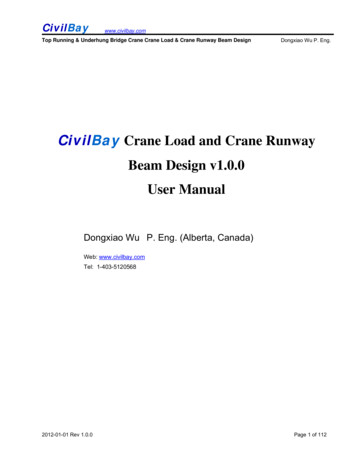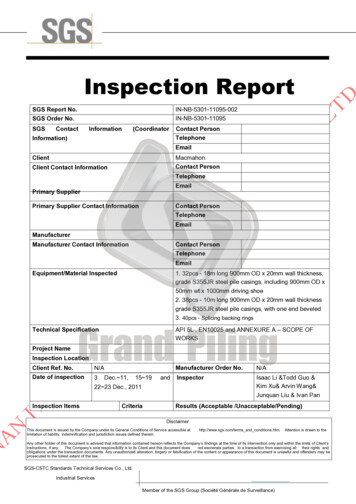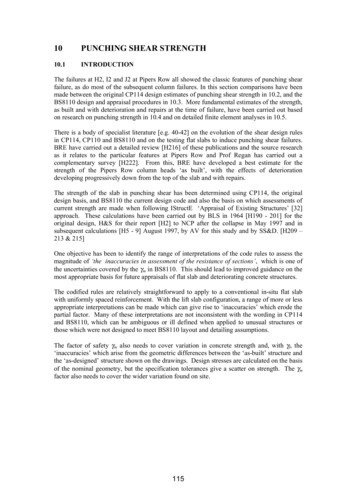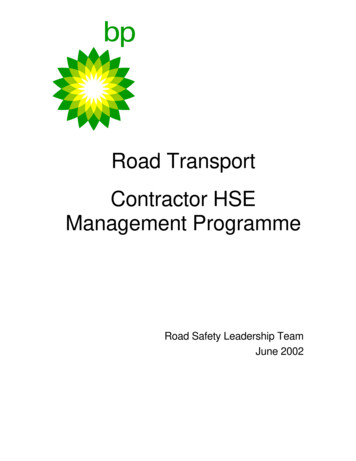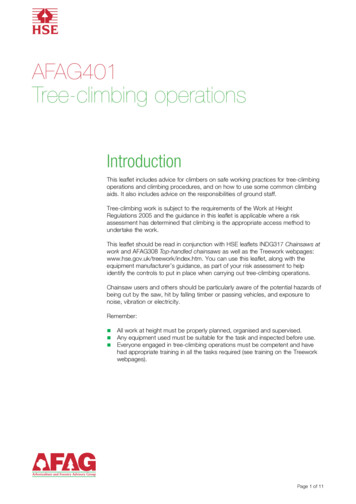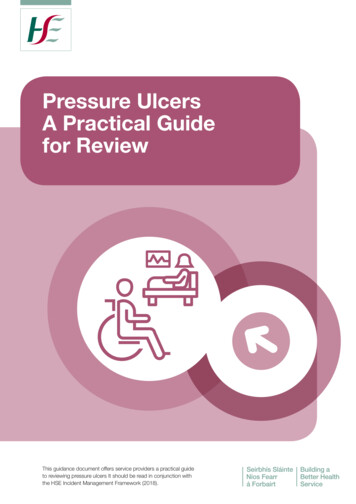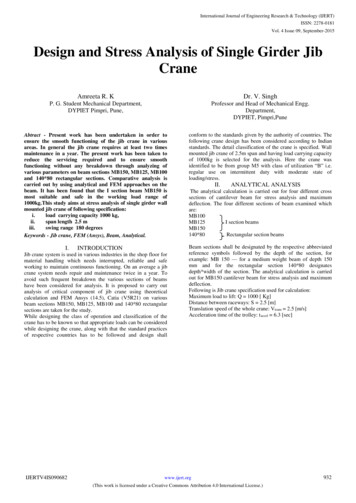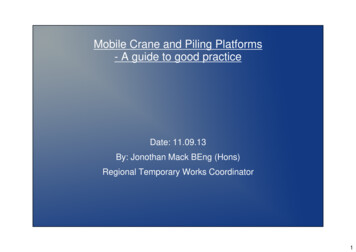
Transcription
Mobile Crane and Piling Platforms- A guide to good practiceDate: 11.09.13By: Jonothan Mack BEng (Hons)Regional Temporary Works Coordinator1
2
3
4
Course Contents 1.0) Summary of BS5975? 2.0) The Design Brief 3.0) Procedural Checks and Inspections5
1.0) Summary of BS59751.1) What does it say with regards to ground conditions1.2) Key procedural controls to comply with the code?6
1.1) What Does it Say about Ground Conditions?a)The maximum allowable bearing pressure for any soil or rock should be selected toprovide adequate safety against ultimate failure and limit the settlement to anacceptable value.b)It is essential that variations in the ground underlying and adjacent to a load beassessed. This includes any cases of variable strata, or when any doubt existsc)When a site investigation is undertaken for the permanent design, it is desirablethat any additional data likely to be needed for temporary works should also beobtained.d)In cases where the filling material is variable in consistency and unable to receiveand transmit loads uniformly, a minimum depth of 0.5 m of the fill should beremoved and replaced by well compacted and stabilized granular material of knownbearing capacity.7
1.2) Key Procedural Requirements?a)Preparation of an adequate design brief.b)The Lifting Plan Checklist.c)Inspection of the works and permit to load.8
2.0) The Design Brief2.1) Establishing ground conditions2.2) Appropriate Ground Investigation and Test Results2.3) Establishing near by hazards9
2.1) Establish Ground ConditionsTo accurately determine the ground conditions it is critical to knowthe differences betweenCohesive Soils&Non-Cohesive SoilsOnly when the soil type is established can an appropriateinvestigation be chosen to ensureThe correct tests forthe soil type areundertaken&The correct information issent to the designer forcalculation of the bearingcapacity.10
NON - COHESIVE SOILSNo interparticle bonding.Friction determines shearstrength.Internal Friction angle (φ), isthe measurement of the shearstrength of soils due to friction.COHESIVE SOILSCohesion between particles givethe soil strength.This is the Cementation betweensand grains Electrostatic attractionbetween clay particlesCohesion (C), is a measure of theforces that cement particles of soils11
2.2) Ground Investigation and Test ResultsWhat types of ground investigation should be used to determine theInternal angle of shear (φ ) for a non cohesive material and thecohesion (C) of a cohesive material?The correct test for the identified soil type can be chosen from anumber ofField testsorLaboratory tests12
Field Tests – a) Shear Vane TestA vane test is carried out in clays up to stiff in consistency to determine itscohesion, and can be operated in an exploratory borehole, or to a limited depth bydirect penetration using purpose-designed equipment.The vane equipment comprises four blades arranged in a cruciform on the end ofrods, which are extended from the ground surface to the test level. The vane ispushed into undisturbed soil, and the rods are rotated by hand cranking via a wormand pinion gear.13
Field Tests – b) Dynamic Probe TestDynamic probing employs a system of rods with a conical hardwearing point,the rods being driven by a drop hammer. It is possible to use dynamic probingto check rapidly and cheaply soil characteristics around large sites therebyallowing the interpolation of data between boreholes.The dynamic probe is a relatively portable and reliable ground investigation toolwhich is used to generate a vertical profile of soil to establish an empirical SPT-Nvalue at different depths. It is therefore suited to non-cohesive soils (sands &gravels etc).14
15
16
17
2.3) Establishing Near by HazardsAny hazards within the ground that may cause the crane to becomeunstable should be considered ifa) They are supporting the ground beneath the craneb) Are close enough to be affected by the crane orc) Which may disturb the established ground conditionsThese hazards if present are to be included within the “Design Brief” to besent to the designer. It is therefore important to be aware ofHow load is transferredthrough the ground beneathan outrigger plate through thesoil.&What can be affected bythe transfer of these loadsfrom a crane through theground?18
Load from an outrigger plate or base may be assumed to spread downthrough the ground at a slope of 1:1 (45 degrees) in both directions.45 degreesThis means that the load from an outrigger or spreader can be transferred to Underground services Nearby foundations Underground drains Manholes or tanks Slopes or excavations Ground works19
These examples show some failures due to the placement of the crane outriggers overhazards or close to hazards. So what hazards may have been the cause?20
21
22
So by ensuring that a designer is issueda) The location of the liftb) The maximum load or pressure to be placed on the groundc) Whether the soils are cohesive or non cohesived) The possible nearby hazardse) The results of ground investigations at the location of the lift/loadA suitable design brief will have been provided to theTemporary Works Designer.23
24
3.0) Check Lists and Inspections3.1) Lifting Plan Check List3.2) Inspection form / Permit to Load25
3.1) Lifting Plan Check ListA check list should be used to ensure that the lifting plan is compliant withthe information issued within the design brief. Items that are often missedand should be included are as follows :ItemThe position of any liftsdrawn to scale on planincluding dimensions.The type and size of cranebeing providedThe max radius, height andweight of the liftReasonTo ensure outriggers sit onthe designed platform. Toensure they are not placedcloser to hazards.A different crane could placehigher loads on the ground thanallowed for in the design.Outriggers spacing can bedifferent placing them off theplatform or nearer hazards.Changes in these will alterthe max. load placed onthe ground by the crane.26
27
3.2) Inspection form / Permit to LoadAn inspection should be undertaken to ensure that the constructedplatform is compliant with the design.28
Questions?29
Influence of Load and Foundation Size on Soils30
4.0) Piling and Piling Rigs4.1) BRE R4704.2) FPS Rig Schedule and WorkingPlatform certificate31
4.1) BRE R470The BRE process considers the various loading conditions under two classheadings. CASE 1 LOADINGThese loading conditions may apply when the rig or crane operator isunlikely to be able to aid recovery from an imminent platform failure.Operations in which this type of loading condition applies could include:StandingTravellingHandling in crane mode e.g. lifting a precast concretepile into the leader, handling casings and reinforcementcages32
CASE 2 LOADINGThese loading conditions may apply when the rig or crane operatorcan control the load safely, for example by releasing the line load,or by reducing power, to aid recovery from an imminent platformfailure.Operations in which this type of loading condition appliescould include:Installing casingDrillingExtracting an augerExtracting casingRig travelling or slewing with a fixed mast which has afoot or fixed load (e.g. pile held in the leader) close to theplatform surface33
4.2) FPS Rig Schedule34
4.2) Working PlatformCertificate35
HSE Enforcement36
Questions?37
an outrigger plate through the soil. & Any hazards within the ground that may cause the crane to become unstable should be considered if a) They are supporting the ground beneath the crane b) Are close enough to be affected by the crane or c) Which may disturb the established ground conditions These hazards if present are to be included within the “Design Brief” to be sent to the designer .
